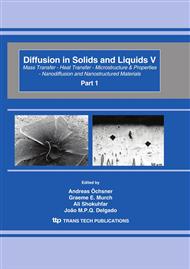p.1395
p.1400
p.1408
p.1414
p.1420
p.1426
p.1432
p.1439
p.1445
On the Significance of Flow Regime for the Heat Transfer in Solid Oxide Fuel Cells
Abstract:
The steady state heat transfer that takes place in a hydrogen-fed tubular Solid Oxide Fuel Cell is considered here. The heat is produced due to the electrochemical reaction of the hydrogen that feds the cell with oxygen anions. An averaging technique is used to formulate a relatively simple one-dimensional heat transfer problem. The conduction-convection equation describing the heat transfer from the electrolyte’s surface to the moving gas that surrounds the cell’s cathode is solved analytically under the assumption of iso-thermal conditions. Three different cases are considered for the flow of the cathode gas: (a) plug flow, (b) fully developed incompressible laminar flow, and (c) compressible flow. Analytical expressions for the spatial distribution of gas and cell temperature along the cell's length are obtained. For constant mass flow rate, different flow regimes produce almost the similar spatial distributions for the gas temperature and, consequently, the consideration of the flow regime is of low importance in the design of fuel cell stacks.
Info:
Periodical:
Pages:
1420-1425
Citation:
Online since:
April 2010
Authors:
Keywords:
Price:
Сopyright:
© 2010 Trans Tech Publications Ltd. All Rights Reserved
Share:
Citation:


